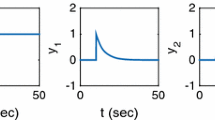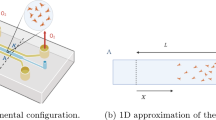Abstract
More than 20 years after its proposal, Keller and Segel's model (1971,J. theor. Biol.,30, 235–248) remains by far the most popular model for chemical control of cell movement. However, before the Keller-Segel equations can be applied to a particular system, appropriate functional forms must be specified for the dependence on chemical concentration of the cell transport coefficients and the chemical degradation rate. In the vast majority of applications, these functional forms have been chosen using simple intuitive criteria. We focus on the particular case of eukaryotic cell movement, and derive an approximation to the detailed model of Sherrattet al. (1993,J. theor. Biol.,162, 23–40). The approximation consists of the Keller-Segel equations, with specific forms predicted for the cell transport coefficients and chemical degradation rate. Moreover, the parameter values in these functional forms can be directly measured experimentally. In the case of the much studied neutrophil-peptide system, we test our approximation using both the Boyden chamber and under-agarose assays. Finally, we show that for other cell-chemical interactions, a simple comparison of time scales provides a rapid check on the validity of our Keller-Segel approximation.
Similar content being viewed by others
Literature
Alt, W. 1980. Biased random walk models for chemotaxis and related diffusion approximations.J. Math. Biol. 9, 147–177.
Alt, W. and D. A. Lauffenburger. 1987. Transient behaviour of a chemotaxis system modeling certain types of tissue inflammation.J. Math. Biol. 24, 691–722.
Balding, D. and D. L. S. McElwain. 1985. A mathematical model of tumor-induced capillary growth.J. theor. Biol. 114, 53–73.
Berg, H. C. 1988. A physicist looks at bacterial chemotaxis.Cold Spring Harb. Symp. Quant. Biol. 53, 1–9.
Bignold, L. P. 1987. A novel polycarbonate (Nuclepore) membrane demonstrates chemotaxis, unaffected by chemokinesis, of polymorphonuclear leukocytes in the Boyden chamber.J. Immun. Meth. 105, 275–280.
Bignold, L. P. 1988. Measurement of chemotaxis of polymorphonuclear leukocytes in vitro.J. Immun. Meth. 108, 1–18.
Boon, J. P. and B. Herpigny. 1986. Model for chemotactic bacterial bands.Bull. math. Biol. 48, 1–19.
Boyden, S. V. 1962. The chemotactic effect of mixtures of antibody and antigen on polymorphonuclear leukocytes.J. exp. Med. 115, 453–466.
Buettner, H. M., D. A. Lauffenburger and S. H. Zigmond. 1989a. Cell transport in the Millipore filter assay.Am. Inst. Chem. Engng Jl 35, 459–465.
Buettner, H. M., D. A. Lauffenburger and S. H. Zigmond. 1989b. Measurement of leukocyte motility and chemotaxis parameters with the Millipore filter assay.J. Immun. Meth. 123, 25–37.
Cassimeris, L. and S. H. Zigmond. 1990. Chemoattractant stimulation of polymorphonuclear leucocyte locomotion.Seminars Cell Biol. 1, 125–134.
Caterina, M. J. and P. N. Devreotes. 1991. Molecular insights into eukaryotic chemotaxis.FASEB Jl 5, 3078–3085.
Chaplain, M. A. J. and A. M. Stuart. 1991. A mathematical model for the diffusion of tumour angiogenesis factor into the surrounding host tissue.IMA J. Math. Appl. Med. Biol. 8, 191–220.
Charnick, S. B., E. S. Fisher and D. A. Lauffenburger. 1991. Computer simulations of cell-target encounter including biased cell motion toward targets: single and multiple cell-target simulations in two dimensions.Bull. math. Biol. 53, 591–621.
Devreotes, P. N. and S. H. Zigmond. 1988. Chemotaxis in eukaryotic cells: a focus on leukocytes andDictyostelium.Ann. Rev. Cell Biol. 4, 649–686.
Falk, W., R. H. Goodwin and E. J. Leonard. 1979. A 48-well micro chemotaxis assembly for rapid and accurate measurement of leukocyte migration.J. Immun. Meth. 33, 239–247.
Farrel, B. E., R. P. Daniele and D. A. Lauffenburger. 1990. Quantitative relationships between single-cell and cell population model parameters for chemosensory migration responses of alveolar macrophages to C5a.Cell. Motil. Cytoskel. 16, 279–293.
Ford, R. M. and D. A. Lauffenburger. 1991. Analysis of chemotactic bacterial distributions in population migration assays using a mathematical model applicable to steep or shallow attractant gradients.Bull. math. Biol. 53, 721–749.
Gex-Fabry, M. and C. Delisi. 1984. Reeptor-mediated endocytosis: a model and its implications for experimental analysis.Am. J. Physiol. 247, R768-R7779.
Harvath, L. and R. R. Aksamit. 1989. Human granulocytes and granulocytes from other species demonstrate differences in chemotactic responsiveness to oxidized N-formyl-methionyl-leucyl-phenylalanine.Comp. Biochem. Physiol. A 92, 97–100.
Janssens, P. M. W. and R. Van Driel. 1984.Dictyostelium discoideum cell membranes contain masked chemotactic receptors for cyclic AMP.FEBS Lett. 176, 245–249.
Janssens, P. M. W. and P. Van Haastert. 1987. Molecular basis of transmembrane signal transduction inDictyostelium discoideum.Microbiol. Rev. 51, 396–418.
Kareiva, P. and G. Odell. 1987. Swarms of predators exhibit preytaxis if individual predators use area-restricted search.American Naturalist 130, 233–270.
Keller, E. F. 1980. Assessing the Keller-Segel model: howe has it fared? InBiological Growth and Spread, W. Jäger, H. Rost, and P. Tautu (Eds), Lecture Notes in Biomathematics, Vol. 38, pp. 379–387. Berlin: Springer.
Keller, E. F. and L. A. Segel. 1971a. Model for chemotaxis.J. theor. Biol. 30, 225–234.
Keller, E. F. and L. A. Segel. 1971b. Travelling bands of chemotactic bacteria: a theoretical analysis.J. theor. Biol. 30, 235–248.
Lapidus, I. R. 1980. Pseudo-chemotaxis by microorganisms in an attractant gradient.J. theor. Biol. 86, 91–103.
Lapidus, I. R. and R. Schiller. 1976. Model for the chemotactic response of a bacterial population.Biophys. Jl 16, 779–789.
Lauffenburger, D. and R. Aris. 1979. Measurement of leukocyte motility and chemotaxis parameters using a quantitative analysis of the under-agarose migration assay.Math. Biosci. 44, 121–138.
Lauffenburger, D., R. Aris and C. R. Kennedy. 1984. Traveling bands of chemotactic bacteria in the context of population growth.Bull. math. Biol. 46, 19–40.
Lauffenburger, D., C. Rothman and S. H. Zigmond. 1983. Measurement of leukocyte motility and chemotaxis parameters with a linear under-agarose migration assay.J. Immun. 131, 940–947.
Lauffenburger, D. A., R. T. Tranquillo and S. H. Zigmond. 1988. Concentration gradients of chemotactic factors in chemotaxis assays.Meth. Enzym. 162, 85–101.
Lentz, T. L. 1971.Cell Fine Structure. Philadelphia: W. B. Saunders.
Maini, P. K., M. R. Myerscough, K. H. Winters and J. D. Murray. 1991. Bifurcating spatially heterogeneous solutions in a chemotaxis model for biological pattern generation.Bull. math. Biol. 53, 701–719.
Murray, J. D., D. C. Deeming and M. J. W. Ferguson. 1990. Size dependent pigmentation pattern formation in embryos ofAlligator mississipiensis: time of initiation of pattern formation mechanism.Proc. R. Soc. Lond. B 239, 279–293.
Nagai, T. and T. Ikeda. 1991. Traveling waves in a chemotactic model.J. math. Biol. 30, 169–184.
Nelson, R. D., P. G. Quie and R. L. Simmons. 1975. Chemotaxis under agarose: a new and simple method for measuring chemotaxis and spontaneous migration of human polymorphonuclear leukocytes and monocytes.J. Immun. 115, 1650–1656.
Omann, G. M., R. A. Allen, G. M. Bokosh, R. G. Painter, A. E. Traynor and L. A. Sklar. 1987. Signal transduction and cytoskeletal activation in the neutrophil.Physiol. Rev. 67, 285–322.
Pittenger, J. B. and C. H. Dent. 1988. A mechanism for the direct perception of change: the example of bacterial chemotaxis.Perception 17, 119–133.
Rivero, M. A., R. T. Tranquillo, H. M. Buettner and D. A. Lauffenburger. 1989. Transport models for chemotactic cell populations based on individual cell behaviourChem. Engng Sci. 44, 2881–2897.
Rosen, G. 1985. Stable heterogeneous spatial distributions of oxygen and chemotacticescherichia coli with Verhulst limited population growth.J. theor. Biol. 112, 877–881.
Rothman, C. and D. Lauffenburger. 1983. Analysis of the linear under-agarose leukocyte chemotaxis assay.Ann. Biomed. Engng 11, 451–477.
Segel, L. A. 1976. Incorporation of receptor kinetics into a model for bacterial chemotaxis.J. theor. Biol. 57, 23–42.
Segel, L. A. 1977. A theoretical study of receptor mechanisms in bacterial chemotaxis.SIAM J. Appl. Math. 32, 653–665.
Segel, L. A. 1980. Analysis of population chemotaxis. InAnalysis of Population Chemotaxis, L. A. Segel (Ed.), pp. 486–501. Cambridge. Cambridge University Press.
Segel, L. A. 1984. Taxes in cellular ecology. InMathematical Ecology, Proceedings, Trieste 1982, S. A. Levin and T. G. Hallam (Eds), Lecture Notes in Biomathematics, Vol. 54, pp. 407–424. Berlin. Springer.
Segel, L. A., A. Goldbeter, P. N. Devreotes and B. E. Knox. 1986. A mechanism for exact sensory adaptation based on receptor modification.J. theor. Biol. 120, 151–179.
Sherratt, J. A., E. H. Sage and J. D. Murray. 1992. Chemical control of eukaryotic cell movement: a new model.J. theor. Biol. 162, 23–40.
Sklar, L. A., D. A. Finney, Z. G. Oades, A. L. Jesaitis, R. G. Painter and C. G. Cochrane. 1984. The dynamics of ligand-receptor interactions.J. Biol. Chem. 259, 5661–5669.
Smith, G. D. 1985.Numerical Solution of Partial Differential Equations: Finite Difference Methods. Oxford: Clarendon Press.
Snyderman, R. and E. J. Fudman. 1980. Demonstration of a chemotactic factor receptor on macrophages.J. Immun. 124, 2754–2757.
Stickle, D. F., D. A. Lauffenburger and R. P. Daniele. 1985. The motile response of lung macrophages: theoretical and experimental approaches using the linear under-agarose assay.J. Leukoc. Biol. 38, 383–401.
Sullivan, S. J. and S. H. Zigmond. 1980. Chemotactic peptide receptor modulation in polymorphonuclear leukocytes.J. Cell Biol. 85, 703–711.
Tranquillo, R. T., D. A. Lauffenburger and S. H. Zigmond. 1988a. A stochastic model for leukocyte random motility and chemotaxis based on receptor binding fluctuations.J. Cell Biol. 106, 303–309.
Tranquillo, R. T., S. H. Zigmond and D. A. Lauffenburger. 1988b. Measurement of the chemotaxis coefficient for human neutrophils in the under-agarose migration assay.Cell Motil. Cytoskel. 11, 1–15.
Van Haastert, P. J. M. 1983. Sensory adaptation ofDictyostelium discoideum cells to chemotactic signals.J. Cell Biol. 96, 1559–1565.
Van Haarstert, P. J. M. 1987. Down-regulation of cell surface cyclic AMP receptors and desensitization of cyclic AMP-stimulated adenylate cyclase by cyclic AMP inDictyostelium discoideum. Kinetics and concentration dependence.J. biol. Chem. 262, 7700–7704.
Zigmond, S. H. 1981. Consequences of chemotactic peptide receptor modulation for leukocyte orientation.J. Cell. Biol. 88, 644–647.
Zigmond, S. H. 1989. Cell locomotion and chemotaxis.Curr. Op. Cell Biol. 1, 80–89.
Zigmond, S. H. and J. G. Hirsch. 1973. Leukocyte locomotion and chemotaxis: new methods for evaluation and demonstration of a cell-derived chemotactic factor.J. Exp. Med. 137, 387–410.
Zigmond, S. H., S. J. Sullivan and D. A. lauffenburger. 1982. Kinetic analysis of chemotactic peptide receptor modulation.J. Cell Biol. 92, 34–43.
Zimmerli, W., B. Seligmann and J. I. Gallin. 1986. Exudation primes human and guinea pig neutrophils for subsequent responsiveness to chemotactic peptide N-formylmethionylleucylphenylalanine and increases complement component C3bi receptor expression.J. Clin. Invest. 77, 925–933.
Author information
Authors and Affiliations
Rights and permissions
About this article
Cite this article
Sherratt, J.A. Chemotaxis and chemokinesis in eukaryotic cells: The Keller-Segel equations as an approximation to a detailed model. Bltn Mathcal Biology 56, 129–146 (1994). https://doi.org/10.1007/BF02458292
Received:
Issue Date:
DOI: https://doi.org/10.1007/BF02458292




